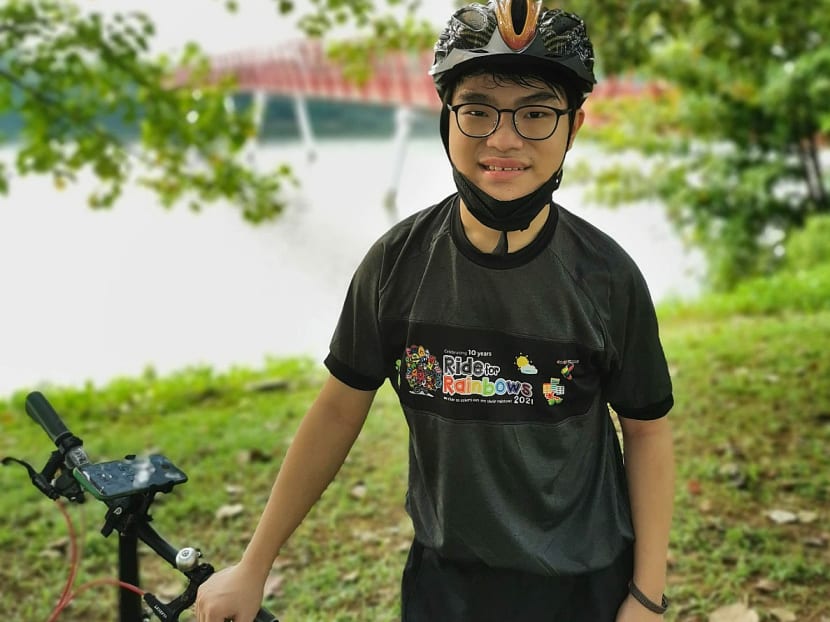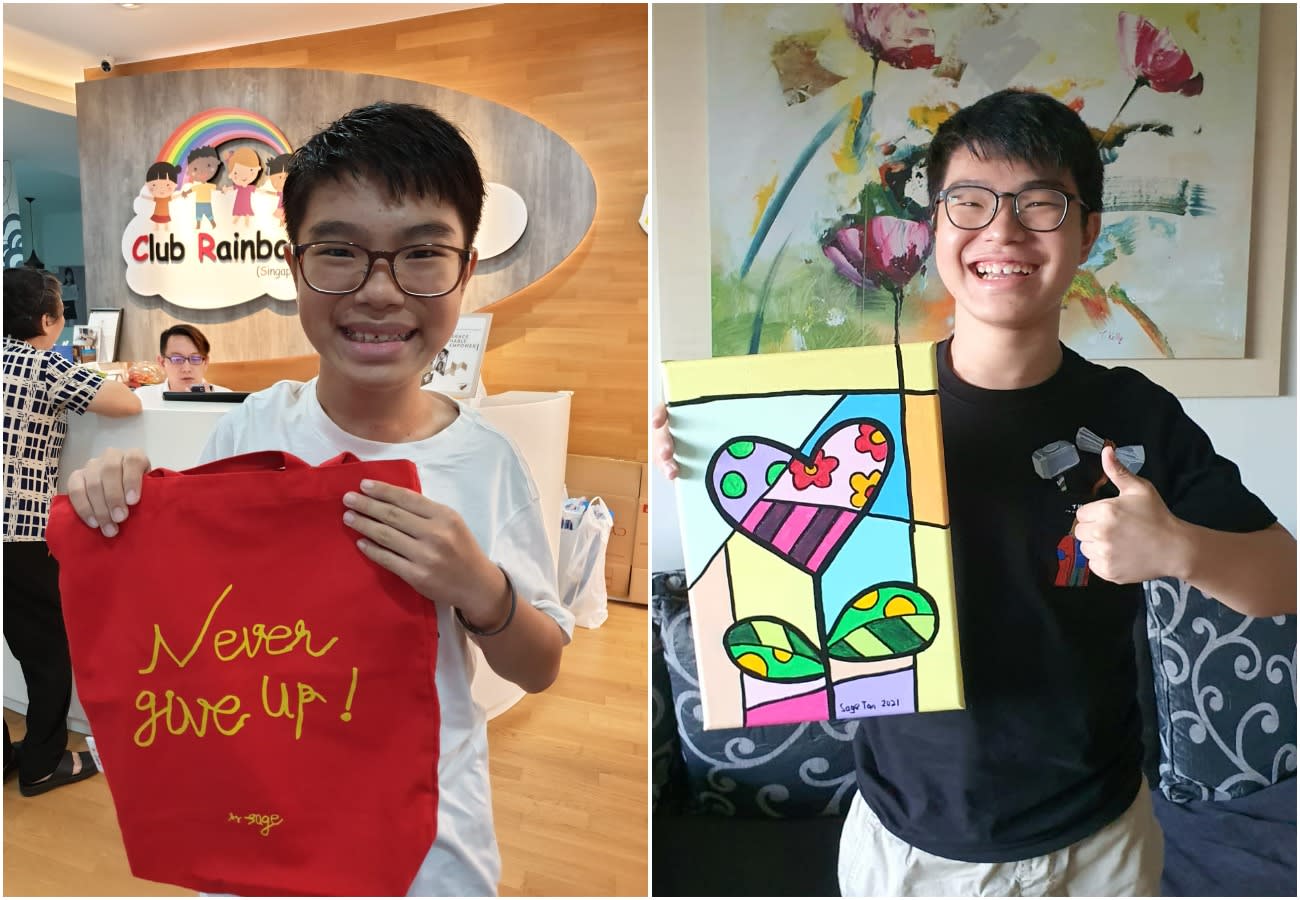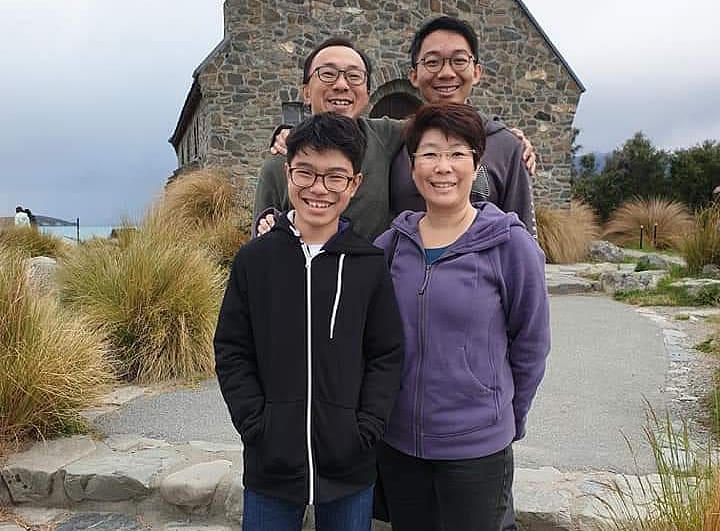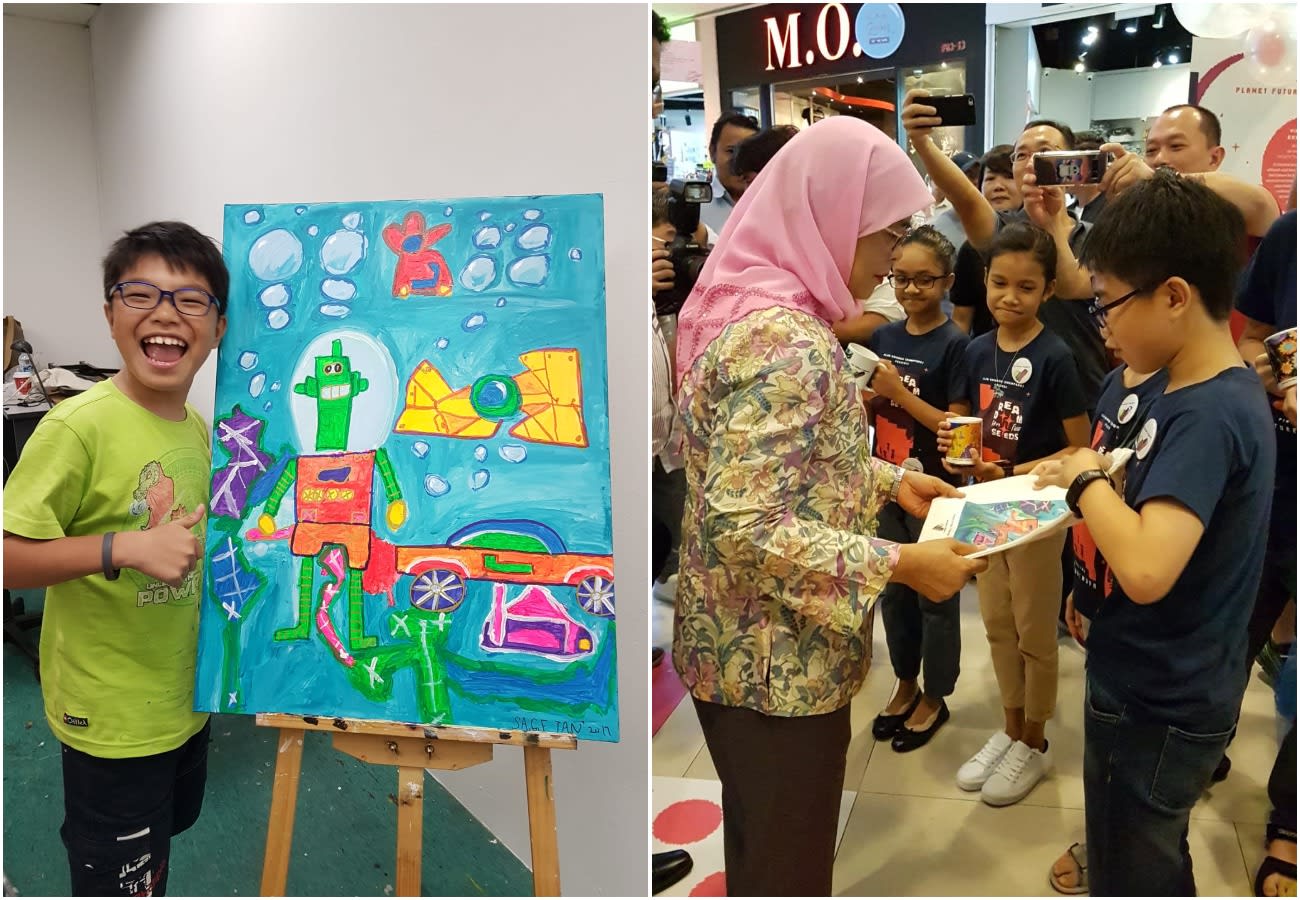A rare disease diagnosis came too late for this boy, who says he’s not ‘poor thing’
SINGAPORE — At just two weeks old, baby Sage Tan slipped into a life-threatening coma and a diagnosis just 14 days after birth was considered too late for him.

Sage Tan, 16, making an effort to learn to cycle for a Club Rainbow (Singapore) charity event.
- At just two weeks old, Sage Tan went into a life-threatening coma
- He has Maple Syrup Urine Disease and there was a short delay in diagnosis
- His body was unable to process and break down certain amino acids, which are formed when the body digests protein food
- He survived several near-death experiences and his mother wants to raise awareness on the rare disease
- She advised parents not to skip newborn screening tests because early diagnosis and treatment of rare diseases can save lives
SINGAPORE — At just two weeks old, baby Sage Tan slipped into a life-threatening coma and a diagnosis just 14 days after birth was considered too late for him.
Before he was four years old, he already had two liver transplants. Now 16, he has survived several painful, near-fatal experiences.
The Singaporean teenager has a rare genetic disorder known as Maple Syrup Urine Disease (MSUD), which is estimated to affect one in 185,000 infants worldwide.
People with the genetic disorder cannot break down branched chain amino acids, which are formed when the body digests protein food such as milk — the main sustenance for babies.
The rare disease can be deadly if treatment is not given in time. One of the symptoms is a distinctive sweet-smelling urine, hence its name.
Associate Professor Denise Goh from National University Hospital (NUH) said that in Singapore, three cases of MSUD were picked up during newborn screening between July 2006 and September 2020.
She is the head of division of paediatric genetics and metabolism at NUH’s Khoo Teck Puat – National University Children’s Medical Institute.
Sage’s rare disease was not detected at birth. His mother, Mrs Cindy Tan, 50, said that the late diagnosis — two weeks after he was born — affected some parts of his brain.
Elevation of leucine — one of the branched chain amino acids that cannot be broken down in a person with MSUD — can cause brain damage, Assoc Prof Goh said.
Mrs Tan, who works as a freelance arts instructor, said that when Sage was born in 2005, newborn screening tests for rare metabolic disorders such as MSUD was not available.
Despite his multiple brushes with death and struggles with several health challenges, the resilient boy remains undaunted and upbeat.
He and his mother spoke to TODAY over a Zoom interview to raise awareness of rare diseases on Rare Disease Day, which was earlier this week on Feb 28.
Sage is studying at Spectra Secondary School and will be taking his N-Levels this year.
A Club Rainbow (Singapore) beneficiary since he was two years old, Sage has taken part in various fundraising activities hosted by the non-profit organisation. It supports children with chronic illnesses.
The most recent activity took place last year. For a charity event called Ride for Rainbows, Sage cycled a distance of around 75km over several days with his father Thomas Tan, 50, a business development manager.
Cycling long distances is not easy for Sage. He took a whole year to learn to ride on a two-wheel bicycle, but he never thought of giving up.
Sage has high muscle tone around the ankles, which makes it tougher for him to flex his ankles. The condition is related to his brain being affected by an untreated MSUD in the early days, Mrs Tan said.
As a baby, he took a longer time than his peers to sit up, crawl and walk.
Sage said: “When I was cycling, I told myself that we (my dad and I) had to keep moving on. I wanted to help raise more funds for other kids so that they join Club Rainbow, too.”
Club Rainbow (Singapore) is now supporting 183 children with rare diseases and their families, who make up 16 per cent of its beneficiaries. It also supports children with neurological disorders and developmental issues.

Ms Nurulhuda Abu Bakar, head of social work at Club Rainbow (Singapore), said that families and caregivers of children with rare diseases experience long-term emotional, financial and caregiving stress due to the life-time condition.
Due to the symptoms of their rare condition, children may also have body image issues, lower self-esteem and face greater challenges in their daily living, she added.
Besides financial assistance, the organisation provides support in several ways, such as therapy services, educational support and vocational development and art development.
It also has a caregiver support group for parents of children with rare syndromes and inborn errors of metabolism.
DRINKING MILK ALMOST KILLED HIM
At birth, there were no signs to show that Sage has a rare disorder. His older brother, 21, does not have the disease.
Mrs Tan, who has just two children, recalled that her younger son was an unusually sleepy baby. By the 10th day, he hardly woke up for his milk feeds.
The doctors who first saw Sage in the hospital were baffled by the symptoms and did not know that protein from milk was toxic to him.
“In the hospital, he was tube-fed with the best, high-protein milk and he went into a coma,” Mrs Tan said.
Sage was eventually transferred from a private hospital to NUH, where Assoc Prof Goh correctly identified the symptoms and the boy was found to have MSUD using diagnostic tests.
Sage was given dialysis at around two weeks old to remove the toxic build-up in his body. The transfusion was performed manually because his veins were too tiny at the time to fit a catheter.
There was also a mad rush to get him formula milk made for MSUD babies.
At every stage, raising a child with a rare disease is never easy, but the toughest time for the whole family was during the toddler’s early years.
“When Sage was diagnosed, there were no smartphones where we could easily get information on the disease. It was a steep learning curve and difficult period, having to manage his condition by trial and error,” Mrs Tan said.
With her child’s life depending on a special restricted diet, Mrs Tan recalled stressing over calculating, measuring and mixing various components into his formula milk with precision.
There were also other stressful incidents, such as a bad bout of gastroenteritis when he was two years old, which caused symptoms such as diarrhoea and vomiting.
That caused a spike in the amino acid levels in his body, triggering seizures that were damaging to his brain.

In 2009, Sage, who was three-and-a-half years ago then, went through two living-donor liver transplant surgeries.
Sage’s aunt and adult cousin donated part of their livers to give him a chance to live a more normal life without the unpredictable effects from MSUD.
Due to complications during the first surgery, though, part of Sage’s new liver from his cousin did not function properly. The second transplant surgery six months later, using a donor liver from his aunt, was a success.
Assoc Prof Goh said that technically, with a liver transplant, a patient with MSUD is “cured” of the rare disease. Yet, some patients may still get some symptoms when they fall ill or the transplanted liver fails.
“In MSUD, the enzyme responsible for breaking down branched chain amino acids is missing. By doing a liver transplant, we give the patient a liver that has this enzyme,” she explained.
Assoc Prof Goh said that a liver transplant for an MSUD patient has benefits, such as a better lifestyle with less dietary restrictions, better outcomes in terms of intelligence quotient (IQ) and less risk of permanent brain damage.
However, a liver transplant recipient also faces other issues and the patient needs to be under treatment and monitored, she added.
Sage is on immunosuppressants for life and is still being monitored.
Even with a new functioning liver, the effects from MSUD left a permanent mark on him.
Mrs Tan said that he struggles in areas such as language and cognition. His eyesight is also affected and he undergoes therapy for his feeding difficulties.
Other issues such as new food and drug allergies also cropped up after the liver transplant surgery, possibly due to being on immunosuppressant drugs, Mrs Tan said.
'DON'T SKIP NEWBORN SCREENING'
After almost losing her child to a rare disease, Mrs Tan wants to highlight the importance of not skipping medical screening that is now available for all newborn babies in Singapore.
The newborn screening programme was introduced in 2006 after Sage was born in 2005.
“It bothers me a lot knowing that some new parents may skip the screening tests because these tests can help detect rare disorders early. Because Sage was not diagnosed earlier, he went into a coma and it affected his brain.”
The programme screens babies for rare medical disorders, including inborn errors of metabolism, which are disorders involving abnormalities in the breakdown of substances such as protein and fat.
Assoc Prof Goh said that the national newborn screening programme was expanded in 2019 to include other disorders, including:
- Cystic fibrosis, a genetic condition that leads to an accumulation of thick mucus in different organs
- Severe combined immune deficiency, where a child has extremely poor immunity and can develop severe infections
Galactosemia, where babies cannot process milk feeds that contain lactose, and can develop liver failure from ingesting such milk - Biotinidase deficiency, a metabolic disorder whereby the body is unable to recycle biotin leading to a deficiency, resulting in complications such as seizures, developmental delay and low muscle tone
More than 90 per cent of all newborn babies in Singapore undergo this national screening programme. It is done by taking a small blood sample, anytime when the infant is between one and seven days old.
The screening is available at public and private hospitals, and is offered to any newborn by any doctor in Singapore, Assoc Prof Goh said. The cost for the screening varies depending on the healthcare facility where it is done.
“Patients who suspect that they have a rare disease can see a genetic doctor to help with the diagnosis,” Assoc Prof Goh added.
Services for undiagnosed cases are available at NUH’s Khoo Teck Puat – National University Children’s Medical Institute and the KK Women’s and Children’s Hospital.
Assoc Prof Goh said that being diagnosed early would mean early treatment, which reduces morbidity and mortality.
“It also means ending a diagnostic journey earlier, saving cost and emotional distress,” she added.
‘THANK YOU FOR TAKING CARE OF ME’
Sage aspires to become a Lego designer or an artist, and encourages children and youth living with rare diseases to “be ambitious” and “never give up on difficult challenges”.
He was previously selected to produce artworks for fundraising initiatives under Club Rainbow’s arts development programme. In 2017, he met President Halimah Yacob and was elated to learn that she had bought a tote bag with his artwork printed on it.
He passed his Primary School Leaving Examination at the foundation level and will be taking his GCE N-Level examinations this year. The next goal, Mrs Tan said, would be for him to enrol in the Institute of Technical Education.

When asked about his thoughts on his health ordeal, Sage said that some of his friends expressed pity when he told them about it.
“Some say (I am) ‘poor thing’ but I feel I have a better life compared to many friends,” he said.
“Some of my friends told me their parents would scold or cane them when they have bad exam results. But when I show mummy my results, she tells me, ‘It’s okay, try harder’, and my daddy will say, ‘Hmm, good improvement’.
“Thank you, mummy, my number-one supporter, for taking care of me for 16 years.”
After seeing all of Sage’s struggles, Mrs Tan said that every small milestone he achieves such as sitting up, crawling, walking and learning to ride a two-wheel bicycle is a big celebration for the family.
He also worked at an art supplies store last year, as part of his school’s industrial attachment programme. Mrs Tan was proud of Sage for being able to take public transport on his own to go to work and completing the long hours of work.
She hopes that Sage would eventually get a job and have as much of a normal life as he can.
“As parents, we’re not going to be there for our children forever. The main goal is for them to take care of themselves when they grow up,” she said.
RARE DISEASES GO UNDETECTED
A 2017 survey by the Asean+Rare Disease Network found that more than half (60 per cent) of people in Singapore with a rare disease did not know they were suffering from it. The network brings together patient support groups from across Southeast Asia.
Dr Goh Choo Beng, head of medical affairs at pharmaceutical firm Takeda Asia Pacific, said that three new rare diseases are discovered globally every week but challenges in diagnoses remain for this group of patients.
He pointed out that the Bringing Research Innovations in Diagnosis of Genetic Diseases in Singapore programme, or Bridges for short, found that on average, patients received a full diagnosis 7.6 years after the start of the disease.
While quality of life and life expectancy have improved for people with rare diseases due to newer treatments, Mr Kenneth Mah, vice-president and co-founder of the Rare Disorders Society Singapore, said that many patients still have trouble getting a referral.
“Patients do not recognise they may have a rare disease, and physicians may not be referring them to the right specialists,” Mr Mak said.
Dr Goh and Mr Mak were among the speakers at the Rarity to Reality rare disease virtual forum on Feb 28. It covered topics such as developments of rare disease diagnosis and treatment, and existing challenges that patients and their families face.









